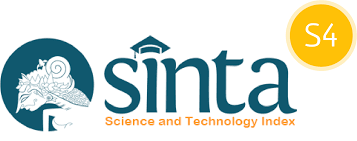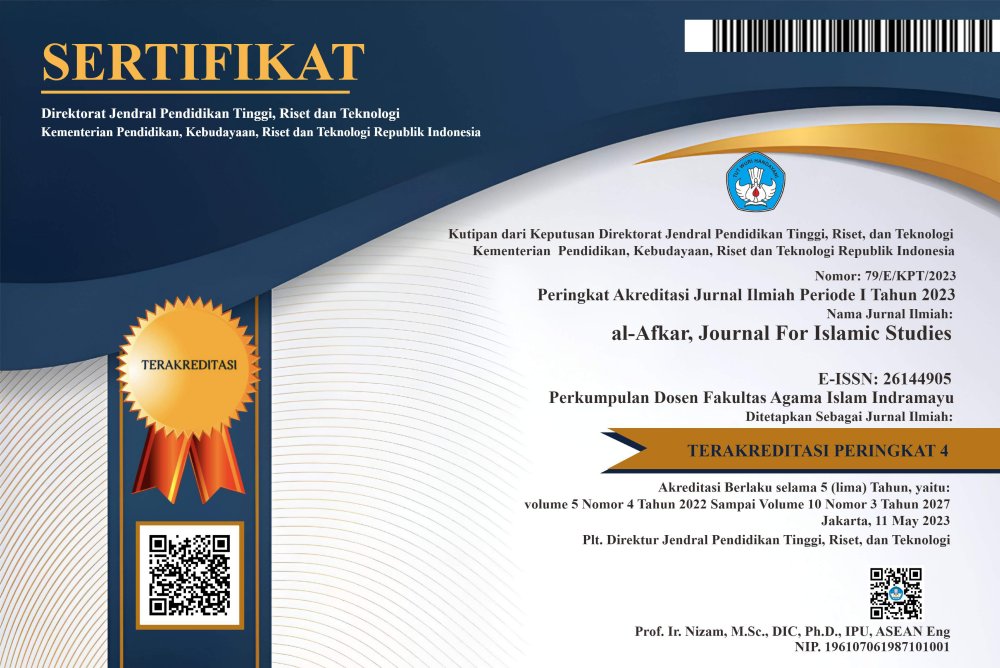Debate on Categories of Da'wah Verses Qs. Ali Imran Verse 64 Between Buya Hamka and Mufassir Nusantara
DOI:
https://doi.org/10.31943/afkarjournal.v7i1.927Keywords:
Da'wah Verses, Indonesian Ulema's Perspective, Da'wah , Buya Hamka, Tafsir Qs. Ali Imran: 64.Abstract
This article discusses the debate of ulama' Nusantara in determining the content in Qs. Ali Imran verse 64 which is categorized as mubahalah verse or da'wah verse. This difference in opinion of the 'Nusantara ulama' can cause controversy among the public, so there is a need for definite clarity in determining the content of the verse, whether it is classified as a mubahalah verse or classified as a da'wah verse? Thus, the purpose of this article is to clarify the content of Qs. Ali Imran verse 64, by comparing the opinions of the four Mufassir Nusantara through the literature study method by collecting data on the opinions of the four scholars' from various sources such as books, journals, and existing researches, as well as collecting and describing in detail verses that can be identified into the category of da'wah verses. This research resulted that Qs. Ali Imran verse 64 can be categorized as a mubahalah verse when viewed from the historical side of the descent of the verse, but this verse can also be used as a benchmark for da'wah verses because it contains elements of da'wah, including such as exclamations, in line with the purpose of da'wah, etc.
Downloads
References
A’yun, Qurrata. “KALIMATUN SAWȂ` in the Perspective of Indonesian’s Interpretation.” Afkaruna 15, no. 1 (2019). https://doi.org/10.18196/aiijis.2019.0095.55-81.
Abarca, Roberto Maldonado. “Kerangka Teoritik.” Nuevos Sistemas de Comunicación e Información, 2021, 2013–15.
Adiansyah, Ridho, Adib Sofia, Muin Bensar, Ali Adams, and Mohamed Ahmed Barakat. “ROLAND BARTHES SEMIOTIC STUDY: UNDERSTANDING THE MEANING WORD OF ’AZAB, A REINTERPRETATION FOR MODERN SOCIETY.” QiST: Journal of Quran and Tafseer Studies 2, no. 3 (July 24, 2023): 255–74. https://doi.org/10.23917/qist.v2i3.1445.
Armayanto, Harda, and Adib Fattah Suntoro. “Konsep Kalimat Sawa’ Dalam Hubungan Antaragama: Analisis Komparatif Pandangan Hamka Dan Nurcholish Madjid.” Al-Misykah: Jurnal Studi Al-Qur’an Dan Tafsir 3, no. 2 (1970): 199–223. https://doi.org/10.19109/almisykah.v3i2.15073.
Ash-Shiddieqy, Muhammad Hasbi. “Tafsir AN-NUUR,” 2000, 1003.
Audah, Mannan. “Strategi Pengembangan Dakwah.” Alauddin University Press, 978-602-328-435-1 3, no. 1 (2021): 10–27.
Fahimah, S. “Ayat-Ayat Dakwah; Kandungannya Dalam Bingkai Penafsiran Alquran.” … : Jurnal Komunikasi Dan Penyiaran Islam 4 (2020): 1–4.
Faisal Purnomosidi, Muhammad, Andri Nirwana AN, and Qoree Butlam. “THE APPLICATION OF THE PRINCIPLE OF COHERENCE IN AL-HASHR: PERSPECTIVE OF QAWAID TAFSIR BY KHOLID BIN UTSMAN AL-SABT.” Profetika: Jurnal Studi Islam 25, no. 01 (February 8, 2024): 15–32. https://doi.org/10.23917/profetika.v25i01.2500.
Fauziyyah, Anisah Nur, Ali Muhammad Asaad, and Abdullah Mahmud. “CHARACTERISTICS OF A HARD HEART FROM THE PERSPECTIVE OF TAFSIR AL-AZHAR.” QiST: Journal of Quran and Tafseer Studies 1, no. 3 (December 19, 2022): 307–28. https://doi.org/10.23917/qist.v1i3.2209.
H Kara, O Anlar MY Ağargün. “Tinjauan Umum Tentang Dakwah Dan Insan Kamil.” Paper Knowledge . Toward a Media History of Documents 7, no. 2 (2014): 107–15.
Hardian, Novri. “Dakwah Dalam Perspektif Al-Qur’an Dan Hadits.” Al-Hikmah: Jurnal Dakwah Dan Ilmu Komunikasi, 2018, 42–52. https://doi.org/10.15548/al-hikmah.v0i0.92.
Hidayat, Syamsul. “The Qoranic View of the World’s Religions Study of the Indonesia Ministry of Religious Affairs’ Al-Quran Dan Tafsirnya and M. Quraish Shihab’s Tafsir Al-Mishbâh.” Revista de Gestão Social e Ambiental 17, no. 5 (June 29, 2023): e03534. https://doi.org/10.24857/rgsa.v17n5-010.
Ii, B A B, Universitas Gadjah, and Mada Berikut. “Bab Ii Kerangka Teori 2.1.,” 2014, 12–39.
JavanLabs. “Surat Al-Ma’idah Ayat 67.” TafsirQ.com, 2015.
Kemendikbud. “Kamus Besar Bahasa Indonesia (KBBI) Kamus Versi Online/Daring (Dalam Jaringan),” 2023.
Mahmudulhassan, M, W Waston, and Andri Nirwana AN. “The Rights and Status of Widows in Islam: A Study from the Perspective of Multicultural Islamic Education in the Context of Bangladesh.” Multicultural Islamic Education Review 1, no. 1 (September 23, 2023): 01–14. https://doi.org/10.23917/mier.v1i1.2674.
Makarim, Muhmmad Ghifari, Hikmawati Rahayu, and Mulia Mardi. “ROLAND BARTHES’ SEMIOTIC ANALYSIS OF THE MEANING OF HARAM IN THE QURAN.” QiST: Journal of Quran and Tafseer Studies 2, no. 3 (September 27, 2023): 331–46. https://doi.org/10.23917/qist.v2i3.2574.
Mathematics, Applied. “Pengertian Dakwah Persuasive,” 2016, 1–23.
Merdeka.com. “Qs. Al-Kafirun Ayat 1-6,” n.d.
Merdeka.com. “Qs. Al-Maidah Ayat 67,” n.d.
Merdeka.com. “Qs. Al-Shaff Ayat 2-3,” n.d.
Merdeka.com. “Qs. Ali ’Imran Ayat 64,” n.d.
Merdeka.com. “Qs. An-Nahl Ayat 125,” n.d.
Munandar, Siswoyo Aris, and Saifuddin Amin. “Contemporary Interpretation of Religious Moderation in the Qur’an: Thought Analysis Quraish Shihab and Its Relevance in the Indonesian Context.” QiST: Journal of Quran and Tafseer Studies 2, no. 3 (2023): 290–309. https://doi.org/10.23917/qist.v2i3.1448.
Musyarrofah, Umi, and Zulhannan Zulhannan. “Religious Moderation in the Discourse of Nahdlatul Ulama’s Dakwah in the Era of Industry 4.0.” Millah: Journal of Religious Studies 22, no. 2 (August 2023): 409–34. https://doi.org/10.20885/millah.vol22.iss2.art5.
Nugroho, Kharis, Muhammad Zawil Kiram, and Didik Andriawan. “THE INFLUENCE OF HERMENEUTICS IN DOUBLE MOVEMENT THEORY (CRITICAL ANALYSIS OF FAZLURRAHMAN’S INTERPRETATION METHODOLOGY).” QiST: Journal of Quran and Tafseer Studies 2, no. 3 (August 21, 2023): 275–89. https://doi.org/10.23917/qist.v2i3.2531.
Nurmalasari, Yuli, and Rizki Erdiantoro. “Perencanaan Dan Keputusan Karier: Konsep Krusial Dalam Layanan BK Karier.” Quanta 4, no. 1 (2020): 44–51. https://doi.org/10.22460/q.v1i1p1-10.497.
Perspektif, Penafsirannya, and Mufassir Di. “Skripsi Nadia Agita,” 2022, 1–56.
Prof. Dr. Hamka. “Tafsir Al-Azhar Jilid 2 (Juz 4,5,6),” 2015, 395–96.
Raihan. “Dakwah Menurut Perspektif Buya Hamka.” Al-Idarah: Manajemen Dan Administrasi Islam 3, no. 1 (2019).
RIMI, ABDUL RAUF. “Penerapan Metodologi Penafsiran Al-Qur’an Dalam Dakwah.” Khazanah Pendidikan Islam 2, no. 1 (2020): 12–21. https://doi.org/10.15575/kp.v2i1.7739.
Rochmah, Nur Hafifah, and Ahmad Munir. “Interpretation of the Quran With a Philantrophic Approach (Tafsir At-Tanwir Study By Majelis Tarjih Dan Tajdid Pp Muhammadiyah).” QiST: Journal of Quran and Tafseer Studies 2, no. 3 (2023): 310–30. https://doi.org/10.23917/qist.v2i3.1903.
Rozy, Yahya Fathur, Anass Benichou, and Nagoor Gafoordeen. “THE HERMENEUTICS INFLUENCE ON FEMINIST EXEGESIS: A CASE STUDY ON AMINA WADUD.” QiST: Journal of Quran and Tafseer Studies 2, no. 3 (October 7, 2023): 369–81. https://doi.org/10.23917/qist.v2i3.2908.
Saprudin, Udin, J Junaedi, K Kerwanto, and Dito Anurogo. “LIMITING THE NUMBER OF POLYGAMIES TO REALIZE ECONOMIC JUSTICE: A HERMENEUTIC ANALYSIS OF MUHAMMAD SYAHRUR.” QiST: Journal of Quran and Tafseer Studies 2, no. 3 (September 28, 2023): 347–68. https://doi.org/10.23917/qist.v2i3.2769.
Setiawan, Muhammad Andi, and Yeti Dahliana. “REGULATIONS FOR MOSQUE AND MUSHALA VOICES IN THE PERSPECTIVE OF THEMATIC INTERPRETATION ON VOICE RULE IN WORSHIP.” QiST: Journal of Quran and Tafseer Studies 1, no. 2 (August 8, 2022): 223–37. https://doi.org/10.23917/qist.v1i2.1074.
Shihab, M Quraish. “Tafsir Al-Mishbah, Al-Imran Dan An-Nisa’,” 2009, 657.
Sutarja, Harun Jaka Prayitno, Waston, Syamsul Hidayat, Mohamad Ali, and Fitrah Sugiarto. “Character Strengthening Model of Religious Moderation Praxis Method to Improve and Develop Student Morale.” Revista de Gestão Social e Ambiental 18, no. 2 (February 27, 2024): e04871. https://doi.org/10.24857/rgsa.v18n2-076.
TafsirWeb. “Surat Ali ‘Imran Ayat 104,” n.d.
Wahid, Abd., Mazlan Ibrahim, Bukhori Abdul Shomad, Andri Nirwana AN, and Damanhuri Damanhuri. “UTILIZING ZUHD HADITHS FOR UPPER-CLASS CRIME PREVENTION.” Jurnal Ilmiah Islam Futura 23, no. 2 (August 4, 2023): 263–82. https://doi.org/10.22373/jiif.v23i2.17353.
Waston, Erham Budi Wiranto, Mudzakir Ali, Noor Achmad, Deddy Ramdhani, Muthoifin, and Andri Nirwana AN. “Islamophobia and Communism: Perpetual Prejudice in Contemporary Indonesia.” Revista de Gestão Social e Ambiental 18, no. 2 (February 27, 2024): e04875. https://doi.org/10.24857/rgsa.v18n2-075.
Yahya, Abdullah Muhammad, Moh Abdul Kholiq Hasan, and Andri Nirwana AN. “Rights Protection Guarantee for the Partners of Indonesian Gojek Company According to Labour Laws No 13 of 2033 and Maqasid.” Al-Manahij: Jurnal Kajian Hukum Islam 16, no. 1 (May 30, 2022): 115–32. https://doi.org/10.24090/mnh.v16i1.6382.
Yanti, Ziska. “Kajian Intertektualitas Ayat Ahl Al-Kitab Dalam.” Hadis Dan Teologi 2, no. 1 (2022): 19–32.
Zaeni, Hassan, Hasan Mukmin, Sultan Syahril, Fitri Yanti, and Aswadi Aswadi. “Dakwah Pemberdayaan Umat Perspektif Al-Qur`an.” KOMUNIKA: Jurnal Dakwah Dan Komunikasi 14, no. 1 (2020): 95–110. https://doi.org/10.24090/komunika.v14i1.3276.
Zain, Arifin, Maimun Fuadi, and Maimun. “Identifikasi Ayat-Ayat Dakwah.” Al-Idarah: Jurnal Manajemen Dan Administrasi Islam 1, no. 2 (2017): 167–88.
Downloads
Published
How to Cite
Issue
Section
License
Copyright (c) 2024 Usamah Abdurrahman, Andri Nirwana AN, Sayed Akhyar

This work is licensed under a Creative Commons Attribution 4.0 International License.



















